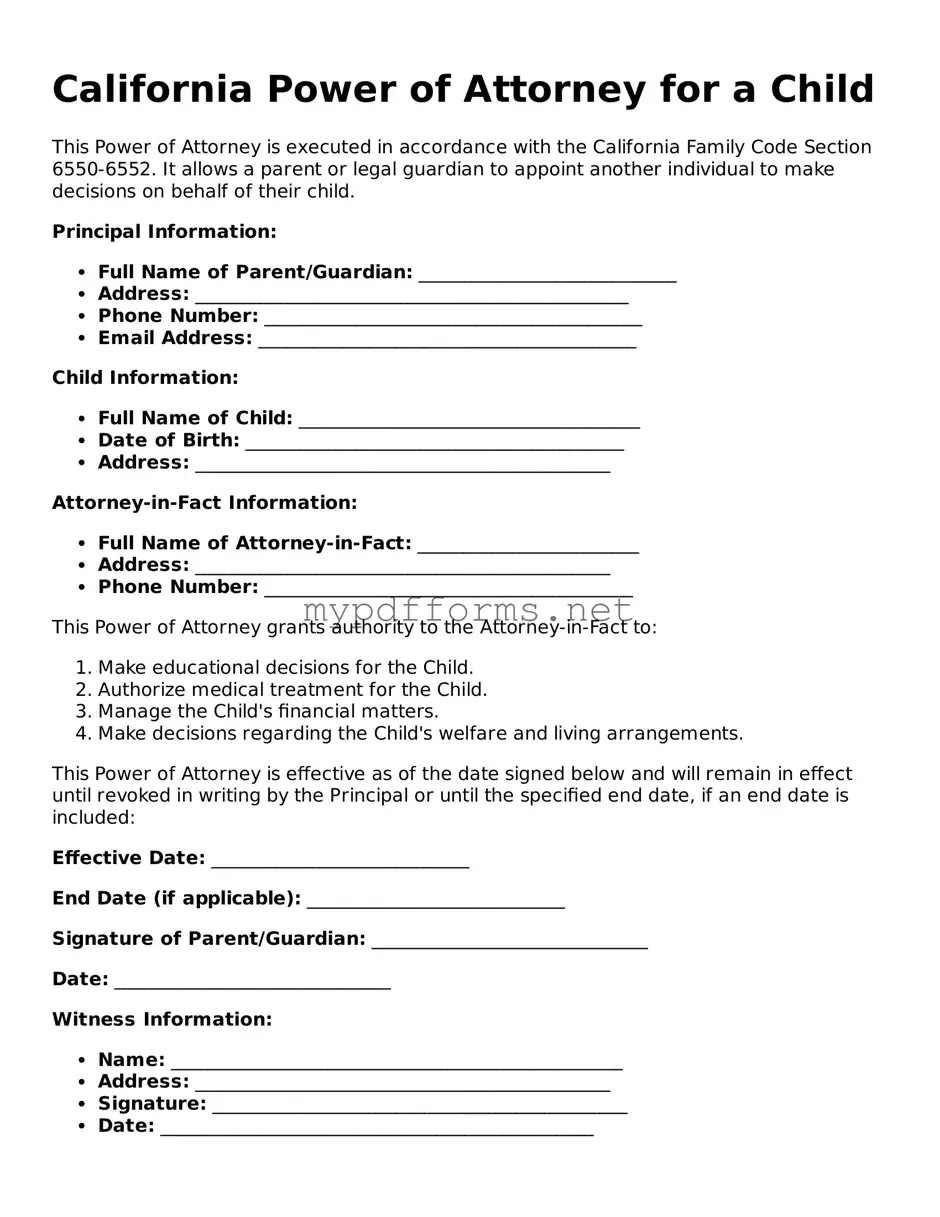The California Power of Attorney for a Child form shares similarities with the General Power of Attorney. Both documents grant authority to an individual to act on behalf of another person. In the case of the General Power of Attorney, it can apply to a wide range of financial and legal matters, while the Power of Attorney for a Child specifically focuses on decisions related to the care and custody of a minor. This tailored approach allows parents to designate someone to make important decisions for their child in their absence, ensuring that the child’s needs are met without the complications that may arise from broader powers.
Another document that bears resemblance to the Power of Attorney for a Child is the Medical Power of Attorney. This form allows a designated individual to make healthcare decisions on behalf of another person. While the Power of Attorney for a Child encompasses various aspects of a child's upbringing, the Medical Power of Attorney is specifically focused on health-related decisions. Parents can use both documents to ensure that their child receives appropriate care when they are unable to be present, thereby safeguarding their child’s well-being.
The Temporary Guardianship form is another document similar to the Power of Attorney for a Child. This form allows a parent to designate a temporary guardian for their child, usually for a specific period. Like the Power of Attorney for a Child, it provides a legal framework for someone else to care for the child. However, the Temporary Guardianship is often more formal and may require court approval, whereas the Power of Attorney can be executed without court involvement, making it a more flexible option for short-term needs.
The Child Custody Agreement is also akin to the Power of Attorney for a Child. This document outlines the arrangements for the care and custody of a child between parents or guardians. While the Power of Attorney allows a parent to delegate authority to someone else, the Child Custody Agreement focuses on the legal rights and responsibilities of the parents or guardians. Both documents aim to protect the child’s best interests, but they do so in different contexts and with different legal implications.
The Consent to Travel form is another related document. This form allows a parent or guardian to give permission for a child to travel with another adult. Similar to the Power of Attorney for a Child, it ensures that the child’s welfare is prioritized while they are in the care of someone else. The key difference lies in the specific purpose; the Consent to Travel is focused solely on travel-related permissions, whereas the Power of Attorney encompasses broader aspects of a child’s care and decision-making.
The Authorization for Release of Medical Records form is another document that parallels the Power of Attorney for a Child. This form permits a designated individual to access a child’s medical records. While the Power of Attorney for a Child allows for broader decision-making authority, the Authorization for Release of Medical Records is specifically geared toward ensuring that the designated person can obtain necessary medical information. This is particularly important when making informed healthcare decisions for the child.
The Special Needs Trust document is also similar in that it involves the care and financial management for a child, particularly one with special needs. This trust allows for the management of funds to ensure the child’s needs are met without jeopardizing their eligibility for government benefits. While the Power of Attorney for a Child focuses on decision-making authority, the Special Needs Trust provides a financial framework to support the child’s long-term care and well-being.
The Adoption Agreement shares a connection with the Power of Attorney for a Child, as both involve the legal rights and responsibilities concerning a child. An Adoption Agreement formalizes the relationship between the adoptive parents and the child, granting the adoptive parents full parental rights. In contrast, the Power of Attorney for a Child does not change legal parentage but allows temporary decision-making authority, making it a useful tool for parents who may need assistance without relinquishing their parental rights.
The Child Support Agreement is another document that relates to the Power of Attorney for a Child. This agreement outlines the financial responsibilities of parents towards their child. While the Power of Attorney for a Child addresses who can make decisions for a child, the Child Support Agreement focuses on the financial obligations to ensure the child’s needs are met. Both documents work in tandem to provide a comprehensive approach to a child's care and support.
The importance of safeguarding confidential information cannot be overstated, particularly in legal matters such as the Power of Attorney for a Child, where sensitive data may be involved. For those in Illinois, utilizing resources like the Illinois Forms can help ensure the protection of personal details while navigating such agreements effectively.
Finally, the Family Care Plan is similar to the Power of Attorney for a Child in that it outlines arrangements for a child's care in the absence of a parent or guardian. This plan may include details about who will care for the child, where they will live, and how their needs will be met. While the Power of Attorney for a Child provides legal authority for decision-making, the Family Care Plan serves as a practical guide for caregivers, ensuring that the child’s day-to-day needs are addressed effectively.
